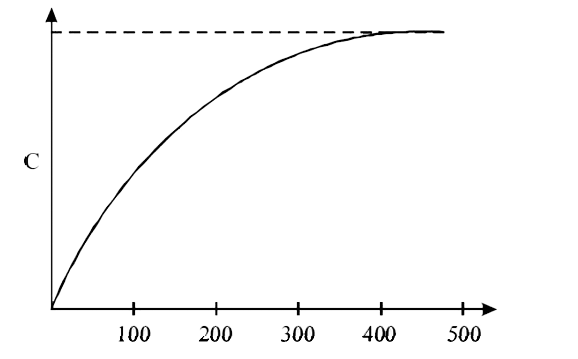Plots showing the variation of the rate constant (k) with temperature (T) are given below. The plot that follows the Arrhenius equation is




The correct Answer is:A
To determine which plot shows the variation of the rate constant (k) with temperature (T) that follows the Arrhenius equation, we can follow these steps:
Step 1: Understand the Arrhenius Equation
The Arrhenius equation is given by:
k=Ae−EaRT
where:
- k is the rate constant,
- A is the pre-exponential factor (Arrhenius factor),
- Ea is the activation energy,
- R is the universal gas constant,
- T is the absolute temperature in Kelvin.
Step 2: Analyze the Relationship
From the Arrhenius equation, we can see that as the temperature T increases, the exponential term e−EaRT increases, leading to an increase in the rate constant k. This indicates that k increases with increasing temperature.
Step 3: Identify the Nature of the Plot
The relationship between k and T is not linear; instead, it is exponential. This means that the plot of k versus T should show a curve that rises steeply as T increases.
Step 4: Examine the Given Plots
Now, we need to examine the provided plots (options) to identify which one shows this exponential increase in k with respect to T.
- Option A: If this plot shows a curve that rises steeply as temperature increases, it is likely the correct answer.
- Option B, C, D: If these plots show a linear increase or a decrease in k with respect to T, they do not follow the Arrhenius equation.
Step 5: Conclusion
After examining the plots, we conclude that the plot that shows an exponential increase in the rate constant k with increasing temperature T is the one that follows the Arrhenius equation.
Thus, the answer is:
Option A.
---
The Arrhenius equation is given by:
k=Ae−EaRT
where:
- k is the rate constant,
- A is the pre-exponential factor (Arrhenius factor),
- Ea is the activation energy,
- R is the universal gas constant,
- T is the absolute temperature in Kelvin.
From the Arrhenius equation, we can see that as the temperature T increases, the exponential term e−EaRT increases, leading to an increase in the rate constant k. This indicates that k increases with increasing temperature.
The relationship between k and T is not linear; instead, it is exponential. This means that the plot of k versus T should show a curve that rises steeply as T increases.
Now, we need to examine the provided plots (options) to identify which one shows this exponential increase in k with respect to T.
- Option B, C, D: If these plots show a linear increase or a decrease in k with respect to T, they do not follow the Arrhenius equation.
After examining the plots, we conclude that the plot that shows an exponential increase in the rate constant k with increasing temperature T is the one that follows the Arrhenius equation.
Option A.
Topper's Solved these Questions
- CHEMICAL KINETICSBOOK - CENGAGE CHEMISTRY ENGLISHCHAPTER - CHEMICAL KINETICSEXERCISE - Archives Integer
2 Videos
- CHEMICAL KINETICSBOOK - CENGAGE CHEMISTRY ENGLISHCHAPTER - CHEMICAL KINETICSEXERCISE - Archives Fill In The Blanks
4 Videos
- CHEMICAL KINETICSBOOK - CENGAGE CHEMISTRY ENGLISHCHAPTER - CHEMICAL KINETICSEXERCISE - Archives Multiple Correct
5 Videos
- CARBOXYLIC ACIDS AND THEIR DERIVATIVESBOOK - CENGAGE CHEMISTRY ENGLISHCHAPTER - CARBOXYLIC ACIDS AND THEIR DERIVATIVESEXERCISE - Exercises Archives (Analytical And Descriptive)
34 Videos
- COORDINATION COMPOUNDSBOOK - CENGAGE CHEMISTRY ENGLISHCHAPTER - COORDINATION COMPOUNDSEXERCISE - Archives Subjective
18 Videos
Similar Questions
The variation of rate constant with temperature is given by the integrated from of the Arrhenius equation, log10k=−Ea2.303RT + constant
where k = rate cosntant and Ea is the experimental activation energy. If for a certain reaction, log10k=−3163.0T+11.899, calculate Ea.
View SolutionFor a certain reaction the variation of rate constant with temperature is given by the equation
lnkt=lnk0+(ln3)t10(t≥0∘C)
The value of temperature coefficient of the reaction is
View SolutionFor a certain reaction the variation of rate constant with temperature is given by the equation
lnkt=lnk0+(ln3)t10(t≥0∘C)
The value of temperature coefficient of the reaction is
View SolutionPlot a graph showing variation of current versus voltage for the material Ga.
View SolutionThe slope of the plot between pV and p at constant temperature is
View SolutionThe following curve represents the variation of Gibbs function 'G' with pressure at constant temperature. Correct match of given plots with the physical state of a substance is

View SolutionRate of reaction (r ) is plotted against temperature (T) for an enzyme catalysed reaction. Which of the following is correct representation ?
View SolutionIf K1= Rate constant at temperature T1 and k2 rate constant at temperature T2 for a first order reaction, then which of the following relation is correct ?
View SolutionThe figure below shows the variation of specific heat capacity (C) of a solid as a function of temperature (T). The temperature is increased continuously form 0 to 500K at a constant rate. Ignoring any volume change, the following statement (s) is (are) correct to a reasonable approximation.

View SolutionThe figure below shows the variation of specific heat capacity (C) of a solid as a function of temperature (T). The temperature is increased continuously form 0 to 500K at a constant rate. Ignoring any volume change, the following statement (s) is (are) correct to a reasonable approximation.

View Solution
